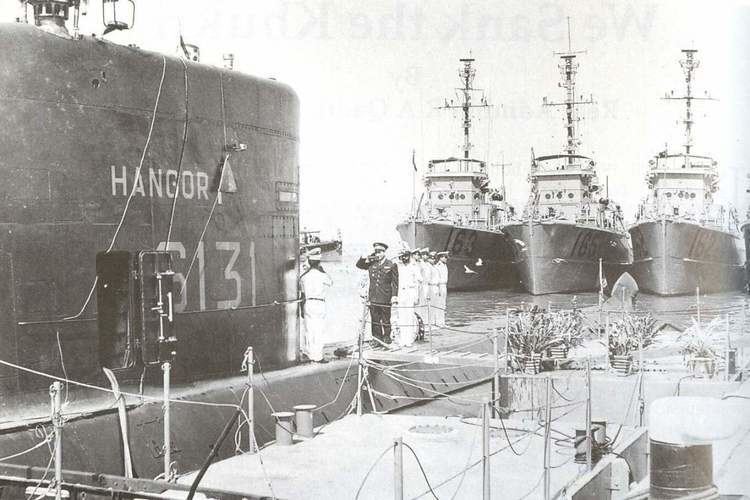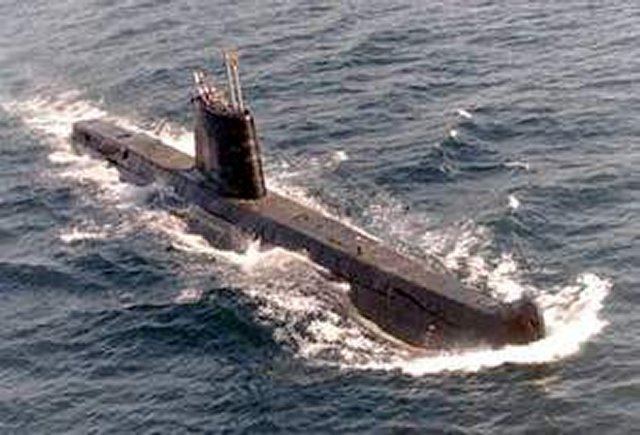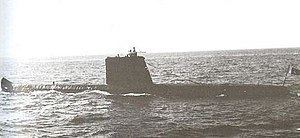Name PNS Hangor Decommissioned 2 January 2006 Length 58 m | Commissioned 20 December 1970 Identification S-131 Launched 28 June 1968 Endurance 30 days 0 hours | |
 | ||
Similar PNS Rahat Hospital, INS Khukri Memorial, Pakistan Maritime Museum, PNS Shifa, Pakistan Army Museum | ||
Pns hangor s131
PNS Hangor (nickname "The Shark") was a Daphné-class submarine that served in the Pakistan Navy from 1970 to 2006. She was built by France and was a diesel-electric submarine. She earned renown when, in the 1971 Indo-Pakistani War, she sank the Indian Navy's anti-submarine frigate INS Khukri with two homing torpedoes. This was the first submarine kill since World War II, and it would remain the only one until a Royal Navy nuclear submarine, HMS Conqueror, sank an Argentine cruiser, General Belgrano, during the Falklands War.
Contents

The sinking inflicted the largest number of casualties on the Indian Navy by the Pakistan vessel during the war which resulted in the loss of 194 Indian sailors, on the night of December 8/9, 1971.

Pns hangor s131
Initial deployment

Hangor was the lead ship of its class and was launched in France on 28 June 1968. The Pakistan Navy commissioned Hangor on 20 December 1970. Many of her crew members over the course of her time in the Pakistan Navy later ascended to senior commanding ranks within the Pakistan Navy. Her one-time commander, Commander Ahmed Tasnim (retiring as Vice Admiral), would later be awarded the Sitara-e-Jurat, Pakistan's 2nd highest military decoration, while her torpedo officers Lieutenant A. U. Khan (later Vice Admiral), Electrical Engineer Officer Lieutenant R. A. Kadri (Later Rear Admiral) and Lieutenant Fasih Bokhari would later command the Pakistan Navy and became senior 4-star rank naval officers.

Hangor was part of one of the Pakistan Navy's earliest submarine squadrons. During late 1971, tensions grew between East and West-Pakistan. On 21 November 1971, the Pakistan Navy began operations in the area, deploying PNS Ghazi under the command of Commander Zafar Muhammad Khan to patrol the distant waters of the Bay of Bengal. Simultaneously, the Pakistan Navy deployed Hangor in the coastal waters of West Pakistan under the command of Commander Ahmed Tasnim. According to Admiral R. A. Kadri, the assigned mission was considered quite difficult and dangerous, with the submarine squadron sailing under the assumption that the dangerous nature of this mission meant a great mortal risk to the submarine and her crew. Both submarines were to maintain coordination & communication throughout patrol operations.
Hangor sailed in the early hours of 22 November 1971 to patrol off the Indian Kathiawar coast. As part of the mission, Hangor cleared the Manora peninsula, Ormara Bay.
Indo-Pakistan War of 1971
On midnight, 2 December 1971, in an attempt to locate a number of possible enemy contacts, PNS Hangor continued her patrol in a northerly direction to investigate radio transmissions intercepted by on-board monitoring equipment. Two contacts were picked up on passive sonar and were identified as warships. The initial range was 6 to 8 miles. The submarine began to stalk the contacts, but an early attempt to gain an attack position on the identified ships failed when Hangor could not match the surface ships' speed. The submarine's crew however managed to predict the target ships' movements and succeeded in working its way into a tactically advantageous position along the path of the patrolling frigates by 19:00.
On the night of 2 and 3 December 1971, Hangor, while lying in wait off Bombay, detected a large formation of ships from Indian Navy's Western fleet which included cruiser INS Mysore. As the Indian naval fleet passed by Hangor very closely, all transmissions were silenced to avoid detection by the Indian fleet. Upon reinstating communications, Hangor provided advance intelligence of a possible attack by the observed Indian armada near the Karachi coast and passed an alert to Pakistani forces stationed in Karachi. These transmissions were intercepted and identified by the Indian Navy. On 3 December, the Indian Navy dispatched two ASW frigates, INS Khukri and INS Kirpan of 14 Squadron - Western Naval Command.
On 9 December 1971, 19:00 hours, Hangor detected the possible signature of the two Indian frigates dispatched in response to the intercepted communications. Later, around midnight, Commander Tasnim ordered Hangor to dive deep to carry out a blind (sonar only) approach and attack. The attack team concentrated on tracking the two targets as they gradually came within firing range. At 19:57 the submarine fired a down-the-throat shot with a homing torpedo at Kirpan from a depth of 40 metres (130 ft). The torpedo was tracked but no explosion was heard. It was then speculated that the torpedo has missed its target, and the moment Kirpan sensed the torpedo, the captain of Kirpan realized that the ship was under attack turned away at maximum speed. Hangor had struck first, but had failed to hit hard.
As Kirpan fled the battle, Khukri, to its south, knowing the direction from which the torpedo had come, increased speed and came straight for an attack on Hangor. As Khukri came in for an attack, Hangor’s attack team shifted targeting to Khukri, quickly obtaining a solution and fired a second torpedo. The second torpedo was fired on the approaching Khukri and was followed by a heavy and loud explosion as the torpedo impacted Khukri. Shortly before the impact, Hangor detected the direct orders of Khukri’s commanding officer Captain Mahendra Nath Mulla ordering evasive maneuvers, however, Khukri was unable to avoid the torpedo. Hangor moved into position to search for possible survivors, however, with Khukri sinking in matter of two minutes, all hands were lost. The casualty roster listed 18 officers and 176 sailors aboard Khukri. It remains as Indian Navy's most costly wartime casualty in terms of lives lost.
Witnessing Khukri sinking as she did, aggravated the commanding officer of her sister ship, Kirpan. Kirpan engaged Hangor with a hasty emergency attack. Sinking a pattern of depth charges, Kirpan hoped to drive Hangor into retreat. However, Hangor continued the engagement, firing a third torpedo locked on to Kirpan's tail. Kirpan quickly disengaged, and increased her speed and successfully evaded the torpedo, though it is reported that it had been damaged in the attack. Hangor disengaged by turning west towards deeper waters. Hangor continued to patrol for another 4 days till the night of 13 December 1971 when she returned safely to her berth. While celebrating her victory, the second half of the mission, Ghazi under the command of Commander Zafar Muhammad Khan patrolling in water near Visakhapatnam, Bay of Bengal, was given the task of laying mines close to the port, a task it was not originally meant for but was restructured in Turkey to include mine laying. During the process one mine exploded and the submarine sank. After the war, indian divers located PNS Ghazi and reported a wide hole blown from inside out. All hands aboard Ghazi died when the submarine sank on the night of 4 December 1971.
Ceremony
In a ceremony on 2 January 2006, Hangor was decommissioned from the Pakistan Navy. She was soon converted to serve as a museum ship at Pakistan Maritime Museum, avoiding the fate of many other PNS submarines bound for scrap. During the ceremony Vice Admiral Ahmed Tasnim, inspected the ship for the last time. Vice Admiral Ahmed Tasnim Sitaria-e-Jurat(SJ) and Bar had served as commander of Hangor during the mission in which she sank Khukri. The transfer of this submarine from a floating dock to the land and then her transportation to Pakistan Maritime Museum far away from the coastline into the land was undertaken by the Pakistan Navy as a project and Commander Muhammad Shakil Naz was the project officer for this challenging task.
